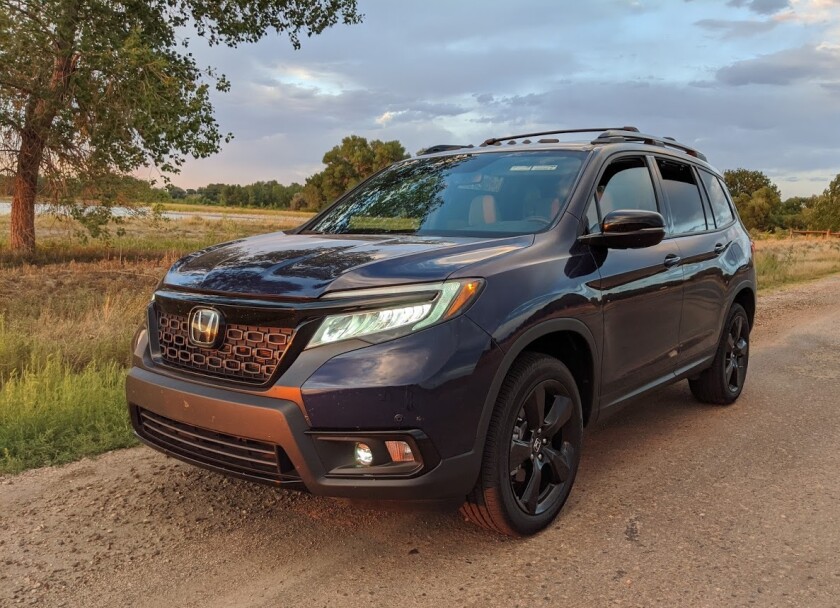Road trips are a summer staple. Visions of long stretches of open highway, windows down, your playlist blaring on the radio. Beef jerky. Lots of beef jerky. Road trips are also a great way to test a vehicle, especially one marketed to the adventurous types and outdoor enthusiasts. One of the latest entrants in this field is the Honda Passport, which is now in its second model year.
Primary Competitors:
- Chevrolet Blazer
- Ford Edge
- Jeep Grand Cherokee
- Nissan Murano
- Hyundai Santa Fe
Disclosure: Honda provided this 2020 Honda Passport AWD Elite to test out for a week.
Quick specs:
- Starting MSRP excluding destination: Sport FWD $31,990, Sport AWD $33,990, EX-L FWD $36,410, EX-L AWD $38,410, Touring FWD $39,280, Touring AWD $41,280, Elite AWD $43,780
- As tested price: $44,900.00
- 3.5L 6 cyl engine 280 horsepower/262 lb-ft torque
- 9-speed automatic transmission
- 265/45R20 all-season tires, 20â painted alloy wheels
- 1st row/2nd row Headroom w/Sunroof (Inches): 39.5/40.0
- 1st row/2nd row Legroom (Inches): 40.9/39.6
- Cargo volume rear seats up/down (CU.FT.): 41.2/77.5
- Fuel Tank (Gals): 19.5
- Fuel Economy (City/Highway/Combined): 19/24/21
- NHTSA Overall Safety Rating: 5 Stars
Honda resurrected the Passport nameplate for the 2019 model year to create an all-new crossover. It's based on a shortened version of the unibody platform that underpins the 3-row Honda Pilot. The V6-powered Passport is offered solely in a 2-row configuration and is positioned directly between the smaller 4-cylinder-only CR-V and larger Pilot. Front-wheel-drive is standard and all-wheel-drive is optional on all trims except the Elite, where it is included as standard equipment. The Elite trim also comes fully loaded with heated/cooled leather seats, 20â black alloy wheels, rain-sensing wipers, heated steering wheel, and wireless phone charger; despite the generous equipment list, it's priced just under $45,000. The most direct competition in this thinly-sliced category includes the Chevy Blazer, Ford Edge, and Nissan Murano.
Honda markets the Passport as their most adventure-capable crossover; this is based on how it sports increased ground clearance, an intelligent AWD system, and better approach and departure angles than even the Ridgeline truck. It's certainly not a true competitor to the rough-and-tumble Jeep Wrangler or Toyota 4Runner by any means, but it could easily take you to your favorite fishing hole or campground. Before you get there, though, there's almost always miles and miles of paved road.
My trip from Southern California to Northern Colorado stood to test the Passportâs merits as an all-around adventure vehicle. Given the 17 hours and 1,100 miles travelled in one day to visit relatives near Fort Collins, CO, there was no way the Passport was going to get out of this test the easy way. That's a lot of time to spend mulling over the Passportâs engine, seats, and overall interior comfort, all while consuming inordinate amounts of beef jerky.
The day started at 3 AM with a couple bags packed and a 55-quart cooler tucked in the 41.2 cubic feet of cargo space behind the second row seats. In the interest of disclosure, I was raised in Southern California. That early in the day, it was a brisk 59 degrees outside. The heated seats and steering wheel were switched on the second I jumped into the driver's seat. Both warmed up quickly and kept me comfortably chill-free for the next couple hours until the sun came up. Meanwhile, the automatic LED headlights cast a wide, bright beam of light on the road and clearly illuminated the path forward.
Out on the open highway, the Passport was a trusty companion. The dark, moonless sky gave way to a cloudless blue day where the heat of the sun pounded the California and Nevada deserts - a perfect opportunity to try out the ventilated front seats. This feature is exclusive to the Passport Elite; the EX-L comes standard with heated front seats, while the Touring and Elite trims are equipped with front and rear heated seats. I found myself keeping the fans on the highest of the three settings the whole time, wondering what good reason there would be for the lower two speeds. Nonetheless, they did keep my back and bottom cool despite the searing outside temperatures, so they worked as advertised.
Knowing Iâd be on the road for the majority of the day, I familiarized myself with Hondaâs suite of driver assist technologies. Standard on all trims are lane-keep assist, auto high-beam headlights, and adaptive cruise control (ACC). Blind spot with cross traffic monitor is standard on all but the entry-level Sport trim. The Passport's ACC proved especially helpful throughout the trip on long stretches of highway, though I did notice a few instances where it didn't seem to pick up the vehicle in front. Out of an abundance of caution, I disabled the system during those rare occasions because the car in front of the Passport was getting too close for comfort. Overall, the assist features performed admirably and helped cut down on driver fatigue.
Countless podcasts and playlists later, I was on my final approach to Fort Collins. After having been on the road for approximately 17 hours straight, it seemed like a good time to check the Passport's average fuel consumption and reflect on my overall comfort. The EPA estimates fuel economy of 19 city, 24 highway, and 21 combined. On a route that involved driving through California, Nevada, a sliver of Arizona, Utah, and the Rockies, I had averaged 26 MPG overall. I exceeded the EPA highway estimate by 2 MPG without even trying; this was in a tall AWD SUV driven at real-world highway speeds, especially considering that the speed limit in most of Utah was 80 MPH. Very impressive, to say the least.
As for seat comfort, I can confidently say Honda has nailed it. Not only was I very pleased with the lack of lower back pain, but the driverâs 10-way power seat was cushy in all the right places with just enough firmness to avoid feeling like a worn-out couch. The seat bottom and side bolsters are mostly flat, which is fine for this type of vehicle. The powertrain is also a perfect fit for the Passport, making for a smooth and effortless drive. Honda's tried-and-true 3.5L V6 engine pairs with a standard 9-speed automatic transmission in all trims, making full use of the 280 horsepower on tap. I had no problem passing slower vehicles or getting up and over the Rockies - even during that one infamous section with a brutal 7% grade.
The Passport features a four-wheel independent suspension with MacPherson struts in the front and a multilink independent rear. This car-based suspension endows the Passport with impeccable road manners, including a supple ride that exhibits none of the vertical bounciness associated with trucks or off-road biased rigs. That said, an 18â wheel and tire combination with a taller sidewall would make more sense - for a vehicle that Honda bills as adventure-ready - than the standard 20â units.
While in Fort Collins, the Passport was used as the primary vehicle to shuttle family to and from: restaurants, a beautiful golf course, and many, many hiking trails. Northern Colorado has so much stunning landscape to explore, but many trails were only accessible via dirt trails that would barely qualify as roads on a map. The Passport tackled the rough dirt roads with aplomb; it's no Trail-Rated Jeep, but you can feel the i-VTM4 torque-vectoring AWD system maintaining traction at all four corners without losing composure. Thanks to its sophisticated drivetrain, the Passport will ferry you to remote campsites or fishing holes on surfaces that other crossovers dare not to tread. It's a great system for what it is, though Iâd imagine it would be more in its element during the winter months as opposed to tackling trails.
When you think of adventure vehicles, the Honda Passport might not be at the forefront. That's no insult to Honda, though - it was never designed to go toe-to-toe with the hardcore off-road rigs to begin with. Depending on what type of adventure you have in mind, the Passport could very well earn its spot at the top of your list. Its all-around versatility makes it a perfect companion in more situations than you can imagine. It surprised me with better-than-expected fuel economy, comfortable seats, a cavernous cabin with great visibility, and a capable all-wheel-drive system. The top-notch NHTSA overall safety rating also brought peace of mind - just in case.
Unfortunately, as with all vacations, they always go too fast. Another 17 hours and 1,100 miles later, the Passport was once again parked in my driveway. Reflecting on the whole week, it finally made sense why Honda chose to bring back this nameplate. A passport gives you access to see and experience different and amazing places abroad. The Honda Passport could be just the right vehicle to take on a road trip to those amazing places right in your own backyard.





























